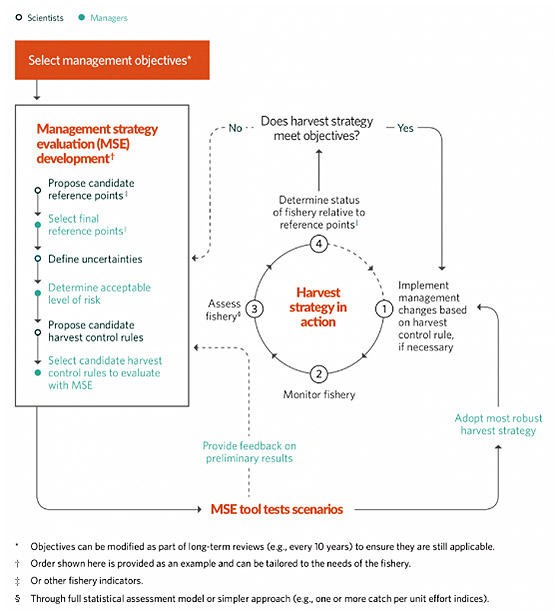Harvest strategies are being used successfully worldwide for all types of fisheries – predators and prey, surface species and bottom fish, international and domestic. Check out our interactive map showcasing the global breadth of harvest strategies in place or development. And if you notice that we are missing your fishery, please let us know!
Harvest strategies can incorporate broader ecosystem considerations into fishery management decisions. Essential elements of successful harvest strategies include management objectives that outline a vision for the future of a fishery, which often includes reference points to define sustainability and harvest control rules (HCR) that set fishing opportunities. Critically, these elements can be structured to account for ecosystem considerations. For example, a management objective might call for leaving a certain amount of fish in the water for the species’ predators.
Like EBFM, harvest strategies are a form of “adaptive management”—that is, they promptly respond to ecosystem conditions to promote fishery stability, resilience, and long-term sustainability. To learn more about how ecosystem considerations can be integrated into a harvest strategy, check out this factsheet.
Managing fish stocks in a rapidly changing climate is an ongoing challenge for fishery managers worldwide. Classic fisheries models recognize that production processes are dynamic but do not account for the long-term trends induced by climate change. Harvest strategies can help adaptively manage climate-vulnerable fish stocks by a) testing climate change scenarios (e.g., changes to stock productivity or natural mortality) in MSE to identify “climate-smart” harvest strategies and b) using the inherent adaptiveness and responsiveness of harvest strategies to quickly modify fishing levels in response to fluctuations in abundance as a result of climate change. For more insights on how harvest strategies can address the impacts of climate change, check out our webinar and blog, where experts delve into the intersection of fisheries management and climate resilience.
Yes, most harvest strategies include review provisions to confirm adequate performance, and all elements of the harvest strategy can be updated if necessary. Adopted harvest strategies are typically re-evaluated every six to ten years. They can be modified if they perform differently than expected or if new knowledge requires a revision of the MSE. Similarly, although MSE and harvest strategies decrease the reliance on traditional stock assessments for informing management actions, benchmark assessments may still be conducted periodically to ensure that the harvest strategy is performing as expected.
In addition to the infrequent reviews, most harvest strategies include “exceptional circumstances protocols” that provide a more regular check for rare and unforeseen conditions the harvest strategy was not designed to handle (e.g., a necessary abundance index is discontinued, and new information about stock productivity). Depending on the significance of an identified exceptional circumstance, it might cause a deviation from the harvest strategy.
One of the key strengths of harvest strategies is their use of a continuous feedback loop that integrates scientific research and data into decision-making. This starts with collecting specific monitoring data to assess the status of the fishery in relation to established reference points and management objectives. This data is then fed into an assessment method that evaluates the current state of the fishery, providing essential insights into stock health, fishing pressure, and other factors.
The results of these assessments are used to inform the harvest control rule (HCR), which is the part of the strategy that dictates how management measures should be adjusted based on the current stock status. The HCR determines whether fishing limits need to be increased, reduced, or maintained to meet the strategy’s long-term objectives. After management measures are adjusted, the process begins again, with new data collected to monitor the outcomes and ensure the strategy remains on track. This continuous cycle of monitoring, assessment, and adjustment helps ensure that harvest strategies remain adaptive and effective over time.
Harvest strategies address uncertainty using a process known as Management Strategy Evaluation (MSE). This process tests the effectiveness of different management approaches across a range of possible future scenarios. It involves evaluating how the harvest strategy would perform under various conditions, such as changes in stock productivity, environmental factors, or illegal fishing levels. By testing these different scenarios, scientists and managers can find the harvest strategy that will perform best, that is, best meet the management objectives, regardless of which scenario comes to fruition.
Although management bodies name and define them slightly differently, all harvest strategies include these basic elements: management objectives; a monitoring program; indicators of the fishery’s status and population health, with associated reference points; a method to assess those indicators; and harvest control rules that set fishing opportunities, which could include catch and size limits, depending on the value of key indicators relative to the reference points.
Reference points are benchmarks used to compare the current status of a fishery management system against a desirable (or undesirable) state. When ingrained in the agreed management objectives for a fishery, they can be used to assess progress toward meeting those objectives. Check out our resources reference points to learn about the different types of reference points and considerations when choosing candidate reference points.
Although different management bodies may take different approaches, harvest strategies are all developed using MSE and generally follow this development process:

Check out our animation that explains harvest strategies, including how they are developed to achieve a long-term vision for a stock and the fisheries that target it.